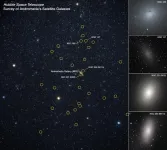ACS includes a group of acute cardiovascular conditions defined by sudden reduced blood flow to the heart muscle expressed with symptoms like chest pain, shortness of breath, and dizziness. The associated conditions of ACS include unstable angina (chest pain) and myocardial infarction (MI or heart attack), which can occur when an unstable coronary artery cholesterol plaque erodes or ruptures, resulting in the formation of blood clots that reduce or completely block blood flow to the heart muscle. Each year, over 800,000 individuals in the United States experience a heart attack.
“Patients with ACS are at the highest risk for cardiovascular complications both acutely and chronically, which emphasizes the importance of staying up-to-date on the most recent evidence presented in this guideline,” said Sunil V. Rao, MD, FACC, FSCAI, Professor of Medicine, the Leon H. Charney Division of Cardiology, Director of Interventional Cardiology at NYU Langone Health and chair of the guideline writing committee. “With appropriate management, we can improve outcomes both in the hospital and over the long term.”
The guideline focuses on the management of unstable angina and myocardial infarction – both non-ST-segment elevation myocardial infarction (NSTEMI) and ST-segment elevation myocardial infarction (STEMI). Recommendations reflect the best evidence to support ACS treatment and management, including updated pharmacologic and procedural care.
Dual antiplatelet therapy (DAPT), comprising aspirin plus a P2Y12 inhibitor, is already recommended for people with ACS. While it reduces the risk of recurrent MI, it can increase bleeding risk in some patients. DAPT is recommended for at least 12 months after hospital discharge for patients with low bleeding risk; several strategies are recommended for patients with a higher bleeding risk.
The guideline stresses the importance of the radial (wrist) approach over a femoral (groin) approach for percutaneous coronary intervention (PCI) in patients with ACS to reduce the risk of bleeding, vascular complications, and death. Reflecting the latest evidence, intravascular imaging to guide the PCI procedure is now a class 1, level of evidence A recommendation.
Cardiogenic shock, a life-threatening condition in which the heart cannot pump enough blood to meet the body’s needs, is estimated to occur in approximately 10% of ACS patients with acute MI. While cardiogenic shock is uncommon, some studies indicate that it is associated with an early mortality rate of 40% to 50%. The guideline provides important recommendations for treating cardiogenic shock: prompt revascularization is fundamentally important, and the guideline continues to give it a class 1 recommendation. Recent clinical trial data is incorporated, as well as consideration of new therapies, such as the microaxial flow pump, based on the benefits and risks for each patient.
Secondary prevention following ACS, focused on reducing progression, recurrence, or complications, is fundamental in the recovery process. Specifically, the guideline includes the following recommendations:
a fasting lipid panel four to eight weeks after initiation or a dose adjustment of lipid-lowering therapy to gauge response or additional medications that may be needed (Class 1); people with ACS on a maximally tolerated statin with an LDL cholesterol greater than or equal to 70 mg/dL should add a concurrent nonstatin lipid-lowering agent, such as ezetimibe, evolocumab, alirocumab, inclisiran or bempedoic acid, to further reduce the risk of major adverse cardiovascular events (Class 1); for people with a lower LDL cholesterol of 55 – 69 mg/dL already on a maximally tolerated statin, it is also reasonable to add a nonstatin to reduce the risk of major adverse cardiovascular events (Class 2a); and referral to outpatient cardiac rehabilitation prior to hospital discharge to reduce death, MI, and hospital readmissions and improve functional status and quality of life (Class 1). In addition to the American College of Cardiology and the American Heart Association, the guideline was written in collaboration with and endorsed by the American College of Emergency Physicians (ACEP), the National Association of EMS Physicians (NAEMSP), and the Society for Cardiovascular Angiography and Interventions (SCAI).
Additional Resources: After Feb. 27, 2025, view the manuscript online in JACC or Circulation.
JACC.org Guideline Hub (at embargo lift – 2 p.m. ET, Feb. 27, 2025) 2025 Acute Coronary Syndromes Guideline-at-a-Glance (at embargo lift – 2 p.m. ET, Feb. 27, 2025) ACC.25 Session: Talking About the New ACS Guidelines – Sunday, March 30, 11:30 am – 12:30 pm CT. AHA Guideline Hub (after embargo – 2 p.m. ET, Feb. 27, 2025) AHA health information: About Acute Coronary Syndrome Follow AHA/ASA news on X @HeartNews Follow news from the AHA’s flagship journal Circulation @CircAHA
The American College of Cardiology (ACC) is the global leader in transforming cardiovascular care and improving heart health for all. As the preeminent source of professional medical education for the entire cardiovascular care team since 1949, ACC credentials cardiovascular professionals in over 140 countries who meet stringent qualifications and leads in the formation of health policy, standards and guidelines. Through its world-renowned family of JACC Journals, NCDR registries, ACC Accreditation Services, global network of Member Sections, CardioSmart patient resources and more, the College is committed to ensuring a world where science, knowledge and innovation optimize patient care and outcomes. Learn more at www.ACC.org or follow @ACCinTouch.
The ACC’s JACC Journals rank among the top cardiovascular journals in the world for scientific impact. The flagship journal, the Journal of the American College of Cardiology (JACC) — and specialty journals consisting of JACC: Advances, JACC: Asia, JACC: Basic to Translational Science, JACC: CardioOncology, JACC: Cardiovascular Imaging, JACC: Cardiovascular Interventions, JACC: Case Reports, JACC: Clinical Electrophysiology and JACC: Heart Failure — pride themselves on publishing the top peer-reviewed research on all aspects of cardiovascular disease. Learn more at JACC.org.
About the American Heart Association
The American Heart Association is a relentless force for a world of longer, healthier lives. Dedicated to ensuring equitable health in all communities, the organization has been a leading source of health information for more than one hundred years. Supported by more than 35 million volunteers globally, we fund groundbreaking research, advocate for the public’s health, and provide critical resources to save and improve lives affected by cardiovascular disease and stroke. By driving breakthroughs and implementing proven solutions in science, policy, and care, we work tirelessly to advance health and transform lives every day. Connect with us on heart.org, Facebook, X or by calling 1-800-AHA-USA1.
###
END





